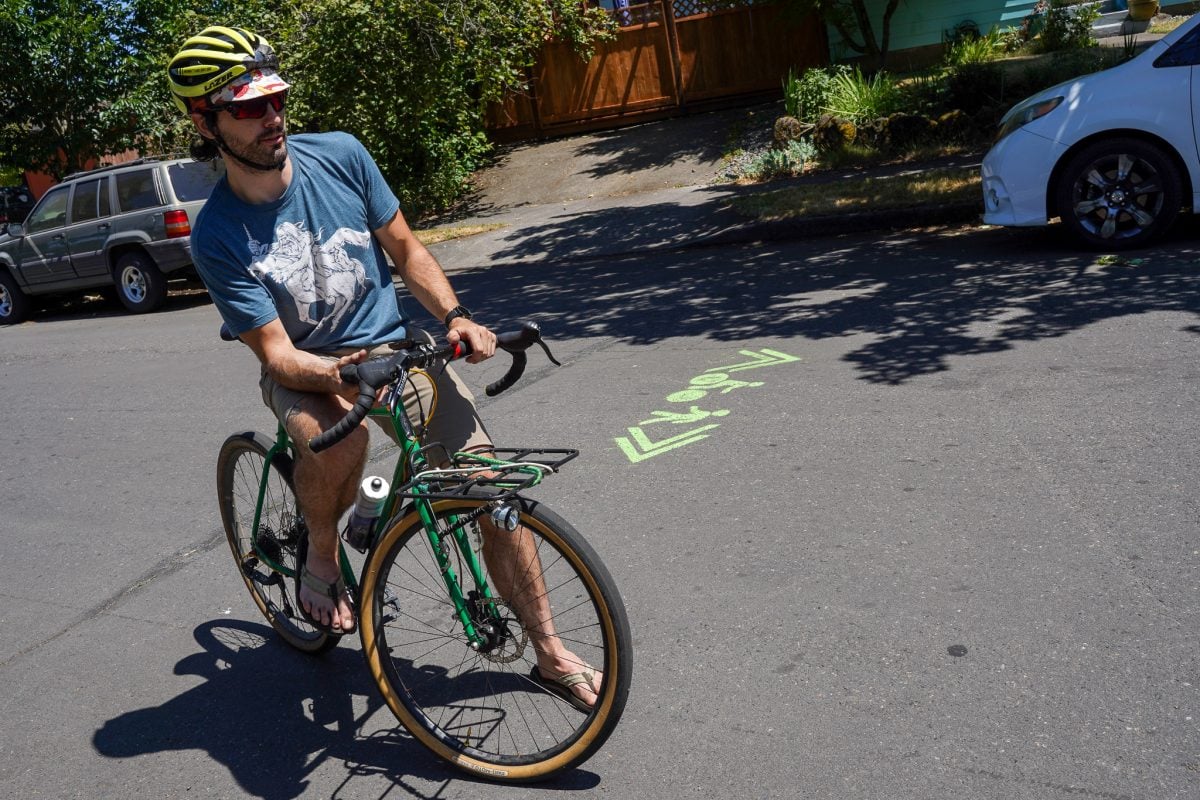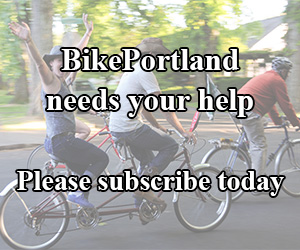Cycling News & Blog Articles
Bike Loud PDX volunteers look to bolster greenways with markings of their own

Bike Loud volunteer Paul Buchanan and one of the new markings on North Houghton.
(Photos: J. Maus/BikePortland)
A group of concerned Portlanders have taken it upon themselves to make neighborhood greenway routes more legible to more people.
“The sharrows just don’t cut it.”
— Nic Cota, Bike Loud PDX
Spurred by conversations at meetings of nonprofit bike activism group Bike Loud PDX, Nic Cota, Paul Buchanan, and Hami Ramani, have begun to lay down pavement markings that complement existing markings installed by the City of Portland. So far the trio have installed dozens of symbols on a three-mile stretch of greenway routes between North Interstate Ave in Kenton and the railroad cut in St. Johns.
Last week I bumped into Buchanan on North Houghton while he was checking out some of their work.
The goal of the DIY project (which doesn’t have an official name yet) is to boost the strength of the existing neighborhood greenway network. According to the Portland Bureau of Transportation, the goal of the 100-miles of existing greenways (formerly known as bicycle boulevards) is for them to be “low-traffic and low-speed streets where we give priority to people walking, bicycling, and rolling.”
But in the eyes of some people, the streets aren’t living up to that promise.
Advertisement
A greenway won’t reach its potential if people don’t know it’s there and don’t know who it’s meant to serve.
“We want to democratize greenways so they work the way they’re supposed to,” explained Buchanan. “The idea is to better define the space and decentralize the message that this space is only for bikes. Greenways are places people should be able to walk their dogs, ride scooters, and use mobility devices. Our goal is to show that greenways are meant to be shared spaces — lateral parks if you will — that can serve every body.”
“The purpose is to serve both as awareness that you’re entering or crossing a Greenway and as a sort of wayfinding.”
— Hami Ramani
The markings, which are cut into stencils and spray-chalked onto the ground, have been done in a green color that is similar to what PBOT uses to mark some bike lanes. According to Hami Ramani, they’ve installed the markings at every street that intersects with a greenway. “This was done to help those approaching the greenway understand that they were about to enter a place where folks will be walking, riding, playing, etc… The purpose is to serve both as awareness that you’re entering or crossing a Greenway and as a sort of wayfinding.”
PBOT has made attempts to improve wayfinding and awareness of greenways. Sharrow markings help point the way, but they can be too infrequent and hard to follow. Sharrows are also a biking-centric symbol that excludes many other types of users. Those green signs that list destinations also help, but there aren’t enough of them to rely on. And some greenways have special sign toppers, but those aren’t always used and are hard to see and understand for most people.
“The sharrows just don’t cut it,” Nic Cota shared with me this week. He said in the weeks they’ve spent installing the markings they observed all types of people using the streets — many of them not on a bicycle. By adding symbols of other types of users, Cota says their markings (which they refer to as glyphs), “Provide a sense of identity for all of these other users the current symbology leaves out. It formalizes the idea that these are greenways where people are prioritized and they are not just ‘bike boulevards’ for bike riders.”
All three of the people involved in this project say they are huge fans of PBOT’s greenway network and they just want to make it better. “Let’s improve them. Let’s make them safer. Let’s double down, triple down, quadruple down on them,” Cota said. “I truly believe the neighborhood greenways are our cities greatest asset to providing safe and effective infrastructure for vulnerable users throughout the city. Let’s build off what we have and what works.”
PBOT has a promising history of listening to feedback like this. It was Bike Loud’s activism that led to updates to the Clinton greenway and the 2015 Neighborhood Greenways Assessment Report.
Cota, Buchanan, and Ramani hope their tactical urbanism is seen not as a nuisance or criticism, but as a cry for help. “Every neighbor was fully supportive as we were out implementing them,” Cota said. “Most folks want this. I think the next step is showing the city we need this.”
— Jonathan Maus: (503) 706-8804, @jonathan_maus on Twitter and This email address is being protected from spambots. You need JavaScript enabled to view it.
— Get our headlines delivered to your inbox.
— Support this independent community media outlet with a one-time contribution or monthly subscription.


